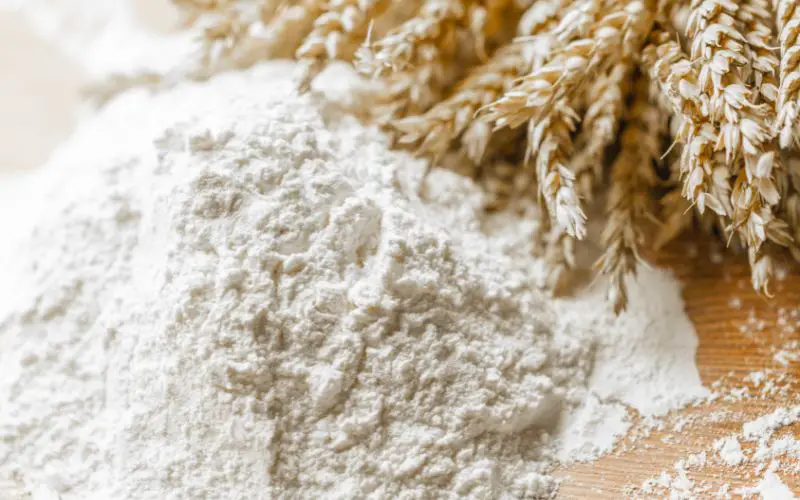Bleached Or Unbleached Flour For Pizza! (In-Depth Guide)
Last updated on September 11th, 2023 at 02:13 pm
There are many alternatives available to make the perfect pizza. You may use several sauces, top your pizza with different toppings, and select the dough type you want.
The issue is, what sort of flour do you need to produce the perfect dough for your pizza?
Unbleached flour is preferable for preparing pizza due to its advantages. It has a thick texture and best suits pastries that need a raising agent. Bleached flour, on the other hand, has a lighter texture and is good for producing pie crusts, cookies, pancakes, quick bread, and waffles.
Here’s a well-laid-out comparison to help you better understand why unbleached flour is the best to use when making pizza.
Which Flour Is Best For Pizza; Bleached or Unbleached Flour?

Unbleached flour has advantages and more benefits than bleached flour which is why you should use it in making your pizza dough.
Here’s a detailed look into both flours to better understand why;
#1. Unbleached Flour
You should use unbleached flour for your pizza dough since it has a higher protein level than bleached flour and is, therefore, more durable.
Due to its strength, unbleached flour offers a fine structure and can withstand the pressure of your pizza’s topping without breaking.
Additionally, the beta-carotene pigment concentration is increased, which improves the flavor and aroma of the dough.
In addition to its distinctive qualities, it offers pizza dough. The fact that it consistently receives the highest praise from experts and other top bakers is convincing proof.
#2. Bleached Flour
Bleached flour is unsuitable for making pizza dough because it has fewer nutrients than unbleached flour.
The bleaching procedure causes a chemical breakdown that lowers the number of nutrients in the flour.
The flavor of bleached flour can be unpleasant. Bleached flour has a distinctly bitter aftertaste than pizza with unbleached flour.
Producers use chemicals to bleach the flour. Only a few of the approximately 20 different chemicals businesses use to bleach flour are employed at any time.
Many individuals are worried about the long-term quality of products treated with chlorine, even though most are considered safe and food-grade.
These preservatives stay in the flour well after the bleaching process and, inevitably, in the baked goods you make with it.
When you make the dough with bleached flour, be aware that the dough won’t be nicer or softer.
It is because the nutrient-rich bran and germ of the wheat kernel have been taken out during the refining process to create bleached flour.
It deprives the grain of many essential vitamins and minerals and leaves just the endosperm.
Afterward, it is treated with chemicals like benzoyl peroxide, potassium bromate, or chlorine to give it a characteristic white hue.
The bleaching procedure hastens the aging of the flour, enhancing its baking properties. It makes it suitable for pie crusts, cookies, and pancakes.
The final product’s flavor, texture, appearance, nutritional makeup, and potential baking uses are all changed by this chemical process.
The flour becomes whiter, softer, and finer-grained after this treatment.
In addition to altering the flour’s physical properties, bleaching increases the dough’s viscosity and machinability.
The table below compares major differences between bleached and unbleached flour to help you understand better;
| Features | Bleached Flour | Unbleached Flour |
|---|---|---|
| Appearance/Color | White | Beige |
| Texture | Soft | Coarse |
| Nutrient | Less nutritious | More nutritious |
| Processing | Chemically processed | Naturally processed |
| Aftertaste | Bitter aftertaste | No aftertaste |
Is Unbleached Flour a Good Alternative For Making Pizza?
Unbleached flour is unquestionably a great alternative since it naturally meets the needs for making the dough for your pizza.
Even though many individuals have been given different types of flour on the market, they continue to discover that unbleached flour works best for pizza dough.
You may use unbleached flour for almost everything, but it’s excellent for making a thin pizza crust.
It is so because unbleached flour contains less gluten than other flour.
Together with other ingredients for pizza dough, it won’t make the dough rise as high as dough that contains more gluten because of its reduced gluten concentration.
Unbleached flour tends to tear more easily than other flours, which makes it occasionally tougher to stretch out than other flours.
It is another factor to keep in mind while using unbleached flour as a component in pizza dough.
Due to its high protein content, the dough’s flexibility and integrity are placed into an optimum state, enhancing the flavor and deliciousness of every bite of the pizza.
It makes it clear why unbleached flour is the top suggestion. Therefore, if you want to make a pizza that goes well with the toppings and melted cheese, make sure the dough is light, fluffy, and cream-colored.
Instead of simply making a conventional pizza at home, you should experiment with it to improve it.
Which Is a Quick-rise Flour For Pizza; Bleached or Unbleached Flour?
In pizza and other pastries, bleached flour rises more quickly than unbleached flour.
It results from the bleaching process’ usage of chemicals like chlorine gas and benzoyl peroxide.
The producers expose bleached flour to an oxidizing chemical, which partially denatures the gluten and facilitates the flour’s ability to rise.
Bleaching makes flour whiter. The chemicals remove the flour’s yellowish color, which also lightens the texture of the flour.
Bleached flour is more likely to rise while baking since the flour is less dense than unbleached flour.
On the other hand, as unbleached flour gets naturally bleached by exposure to air, the texture is unaffected, and the natural whitening of the flour occurs.
Unbleached flour is a little beige and coarser than bleached flour, but it’s still remarkably easy to use for fun baked products.
It rises extremely well, too, for making dough, except bleached flour rises faster than it does.
Although many people think bleached flour is best for pastries since it rises better than unbleached flour, the truth is that variations in how these flours rise are quite subtle.
The main distinction is in the production process and what’s in them.
Conclusion
Unbleached flour is ultimately the best type of flour to use for preparing pizza dough. It contains more protein than bleached flour and hence lasts longer.
Additionally, since it is more nutritious and lasts longer, it’s best to choose it over bleached flour and make your delicious homemade pizza.






